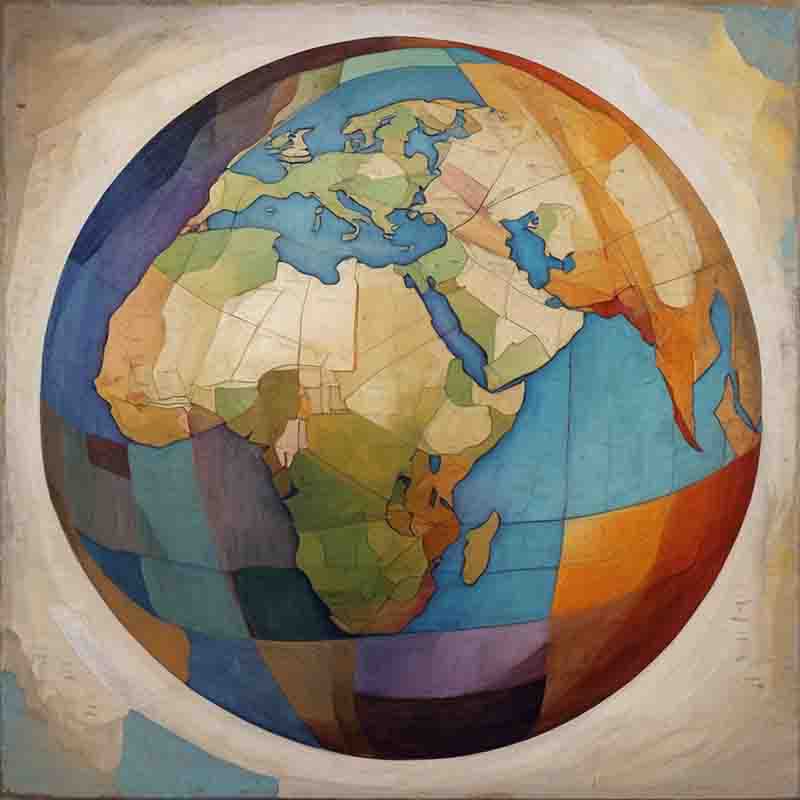Strengthening Ties at Kazan
The 2024 BRICS Summit held in Kazan, Russia, from October 22-24 highlighted BRICS' strategic vision for a collaborative future among emerging economies, focusing on sustainable development, financial independence, and geopolitical stability.

Kazan, the vibrant capital of Tatarstan, hosted the 16th BRICS Summit in October 2024.
The 16th BRICS summit marked a significant moment in the expansion of organisation, as Egypt, Ethiopia, Iran, and the United Arab Emirates (UAE) officially joined the bloc, enhancing its global influence.
The summit focused on deepening political, security, trade, and investment cooperation among member states.
Leaders emphasized the importance of collaboration to foster economic resilience and stability, particularly in the face of global challenges.
A major topic of discussion was the push for greater financial independence among BRICS nations.
BRICS members reaffirmed their commitment to fostering a multipolar world that emphasizes democracy and inclusivity.
A significant initiative discussed was the creation of a new investment platform aimed at supporting sustainable development in Africa and South Asia.
The BRICS Declaration 2024, the formal statement was issued at the end of the summit, outlining the collective vision, commitments, and action plans of BRICS nations.
Following the Kazan meeting, the Valdai Club Forum was held in Sochi, emphasizing the importance of the BRICS as a platform for cooperation and influence on the global stage.
What does the future hold for BRICS
The actions of BRICS nations, the response of established powers, and the choices made by other countries will all play a role in shaping the world of tomorrow.
✅ Subscribe and become a channel member:
The world watched closely when the BRICS nations met in Kazan, knowing that the decisions reached here would influence for years to come everything from trade dynamics to geopolitical alliances.
12 Important Facts about the BRICS Summit in Kazan 2024
-
Dates and Location: The summit was held from October 22 to 24, 2024, in Kazan, Russia, a melting pot of religions.
-
New Member Countries: At this summit, Egypt, Ethiopia, Iran, and the United Arab Emirates (UAE) were officially welcomed as new members of BRICS, expanding the bloc's membership.
-
Focus on Cooperation: The summit emphasized strengthening cooperation among member nations in key areas such as politics, security, trade, and investment.
-
Financial Independence Initiative: Discussions centered around increasing the use of national currencies for trade settlements to reduce reliance on the U.S. dollar and systems like SWIFT.
-
Multipolar World Commitment: BRICS nations reaffirmed their commitment to promoting a multipolar world that is democratic and inclusive, rejecting unilateral sanctions.
-
New Investment Platform: A working group was established to explore creating an investment platform aimed at supporting sustainable development in Africa and South Asia.
-
Participation: The summit was composed of 36 countries, accounting for 57% of the world's population, demonstrating a high level of interest in the BRICS and their initiatives.
-
Peace Initiatives: The member countries expressed support for peace initiatives proposed by China and Brazil, demonstrating a commitment to collaborative diplomacy.
-
Potential Expansion: Leaders agreed on a list of potential partner countries for future inclusion in BRICS+, indicating plans for further expansion.
-
Technological Focus: The discussions included leveraging modern electronic tools to facilitate investments and minimize external risks.
-
Geopolitical Significance: The summit was viewed as a pivotal moment for BRICS to solidify its role as a counterbalance to Western political and economic dominance.
-
Future Expansion: With interest from many countries to join BRICS, the summit agreed on a list of potential partner countries, indicating a strong desire to further expand the group and deepen partnerships within the Global South and East.
The Kazan 2024 Summit: Timeline
The meeting in Kazan, Tatarstan, marked the culmination of Russia's chairmanship.
It provided a platform for high-level discussions, strategic decision-making, and the adoption of key outcomes and agreements among BRICS+ leaders.
Here’s a timetable of the main events during the summit:
| Date | Time | Event | Description |
|---|---|---|---|
| October 22 | 09:00 AM | Opening Ceremony | Official inauguration of the summit with speeches from key leaders. |
| 10:00 AM | Plenary Session I | Discussions among BRICS member states on strategic issues. | |
| 01:00 PM | Networking Lunch | An opportunity for leaders and delegates to engage informally. | |
| 03:00 PM | Plenary Session II | Continued discussions focusing on economic cooperation and security matters. | |
| 06:00 PM | Evening Reception | A meeting for participants to deepen relationships and discussions. | |
| October 23 | 09:00 AM | BRICS+ Forum | Involved representatives from non-member countries to discuss global issues. |
| 12:00 PM | Round Table on Sustainable Development | Focus on collaborative strategies for sustainable growth. | |
| 02:00 PM | Workshop: Digital Currency in BRICS | Discussion on potential unified digital currency among member nations. | |
| 05:00 PM | Cultural Exchange Program | Presentations and performances showcasing the cultures of BRICS nations. | |
| October 24 | 09:00 AM | Closing Plenary Session | Final discussions and resolutions from the summit. |
| 11:00 AM | Press Conference | Leaders addressed media with key takeaways from the summit. | |
| 01:00 PM | Farewell Lunch | Closing gathering to thank participants and conclude the event. |
The Kazan 2024 summit focused on key discussions on multilateralism, economic independence and prospective new members to the BRICS
Kazan 2024: The Future of BRICS

The BRICS nations collectively account for over 40% of the world's population and nearly 25% of the global GDP.
Key Highlights of the Kazan 2024 Summit
On the first day of the summit, Vladimir Putin held meetings with President of the New Development Bank Dilma Rousseff, Narendra Modi, Cyril Ramaphosa, Xi Jinping, and Abdel Fattah el-Sisi.
On the second day of the summit, Luiz Inacio Lula da Silva (via videoconference), Xi Jinping, Abdel Fattah el-Sisi, Abiy Ahmed, Narendra Modi, Masoud Pezeshkian, Vladimir Putin, Cyril Ramaphosa and Abdullah bin Zayed Al Nahyan participated in the expanded meeting of the BRICS Summit.
The Kazan Summit in 2024 is particularly noteworthy as it marked a pivotal moment for BRICS.
Not only did the summit see the inclusion of new member states—Egypt, Ethiopia, Iran, and the UAE—but it also focused on key themes such as financial independence and the establishment of a multipolar world order.
As the BRICS+ nations came together in Kazan, the world watched closely, recognizing that the decisions made here would influence everything from trade dynamics to geopolitical alliances in the years to come.
36 countries took part in the events in Kazan, while the BRICS and their partners have concluded that they will establish a roster of partner countries, which will be extended accordingly.
Kazan 2024 and BRICS+ Expansion: New Members Welcomed
One of the standout features of the Kazan Summit was the welcoming of four new members into the BRICS family which increased the total number of BRICS+ members to nine countries.
-
Egypt joined the BRICS group in January 2024, marking an important geopolitical turning point for the North African country.
-
Ethiopia officially joined the BRICS group in January 2024. This strategic move is expected to bring several benefits to the African nation
-
Iran became a member of the BRICS group on January 1, 2024. This decision was made in August 2023, and it signifies a significant geopolitical shift for Iran.
-
The United Arab Emirates (UAE) officially joined the BRICS group in August 2023. This strategic move positions the UAE as a key player in the global economic and geopolitical landscape.
Saudi Arabia was initially invited to join but has not yet officially become a member. Argentina was also invited but withdrew its application following a change in government in late 2023.
This expansion is not merely a numbers game; it has profound implications for the balance of power in international relations.
The addition of these countries is indicative of BRICS's ambition to create a broader coalition that reflects the changing dynamics of global power.
The expanded BRICS+ group now represents:
-
Approximately 30% of the world's land surface
-
45% of the global population
-
27% of the gross world product (nominal GDP)
-
33% of global GDP based on purchasing power parity (PPP)
-
40% of global trade
-
40% of crude oil production and exports
This expansion has increased the economic and geopolitical weight of the BRICS alliance, potentially challenging the influence of Western-dominated groups like the G7.
By welcoming nations with significant regional influence, BRICS+ aims to enhance its bargaining power and collective voice on the world stage.
This move is strategic, as it helps counterbalance Western influence and offers a united front for emerging economies.
In addition to the confirmed new members, several other nations have expressed interest in joining BRICS.
Countries such as Nigeria, Cuba, Bolivia, Thailand, Vietnam, Malaysia, Indonesia, Belarus, Nigeria, Uzbekistan, Kazakhstan, and Turkey are among those that have indicated a desire to become part of the group.
Themes and Discussions
Financial independence emerged as a primary focus, with discussions centered around reducing reliance on the US dollar for trade and investment.
In addition, the leaders reaffirmed their commitment to establishing a multipolar world order.
By advocating for a more balanced approach, BRICS+ seeks to ensure that the voices of emerging economies are heard and respected in global decision-making processes.
The summit also spotlighted sustainable development initiatives, particularly in Africa and South Asia.
This focus aligns with the group's broader goal of fostering economic cooperation among its members.
Financial Independence: A Major Focus
The leaders emphasized the importance of using national currencies for trade and investment.
This move is significant, as it would help BRICS nations gain more control over their economic destinies.
Although BRICS+ is not creating a direct alternative to SWIFT, it is actively exploring other systems and mechanisms to facilitate smoother trade.
By focusing on national currencies, BRICS aims to minimize vulnerabilities associated with external economic pressures.
Investment Platforms
The summit also introduced the concept of new investment platforms aimed at fostering sustainable development.
This initiative is critical for regions like Africa and South Asia, which have immense growth potential but often lack the necessary funding.
The investment platform aims to provide resources and support for projects that align with BRICS's vision for sustainable growth.
The BRICS New Development Bank (NDB) is expected to play a pivotal role in these efforts.
By financing projects in infrastructure, education, and healthcare, the NDB seeks to uplift communities and promote economic stability.
This focus on investment is crucial for creating opportunities and ensuring that emerging economies thrive in a competitive global landscape.
Strengthening Global Cooperation
The Kazan Summit reaffirmed BRICS's commitment to multilateralism.
In an increasingly polarized world, the coalition seeks to strengthen global cooperation among nations.
The discussions highlighted the importance of collective security measures and mutual support in addressing global challenges.
Leaders emphasized that cooperation is essential for addressing issues such as climate change, food security, and health crises.
By working together, BRICS+ nations aim to create a more stable and secure world for their citizens.
The commitment to multilateralism is not just a slogan; it reflects a genuine desire to collaborate on pressing global issues.
Peace Initiatives
Another noteworthy aspect of the summit was the support for peace initiatives proposed by China and Brazil.
These initiatives focus on conflict resolution and diplomatic engagement in various regions.
The BRICS+ nations recognize the importance of stability and peace for sustainable development, and the discussions in Kazan laid the groundwork for future collaborations.
By prioritizing peace and stability, BRICS aims to position itself as a constructive force in global politics.
The coalition seeks to address conflicts through dialogue and cooperation, rather than confrontation.
This approach is essential for fostering trust and understanding among nations.
Diverse Representation
The Kazan Summit saw diverse representation from various countries, with 35 nations participating in the events.
This level of engagement demonstrates the growing interest in BRICS as a platform for collaboration among emerging economies.
The summit provided an opportunity for member nations to engage with other countries and strengthen partnerships.
Diverse representation also ensures that multiple perspectives are considered in discussions.
This is particularly important in a coalition like BRICS, where member nations have different political, economic, and cultural backgrounds.
By fostering inclusivity, BRICS can create a more comprehensive and effective approach to addressing global challenges.
Building Partnerships
Building partnerships was a key theme at the summit.
Leaders engaged in bilateral meetings to discuss collaboration opportunities in various sectors.
From trade to technology, the focus was on finding common ground and building lasting relationships.
The emphasis on partnerships reflects BRICS's understanding of the interconnectedness of global economies.
In today’s world, cooperation is essential for addressing complex issues that transcend national borders.
The discussions in Kazan laid the foundation for future collaborations that can benefit not only BRICS nations but also the global community.
Shifting Power Dynamics
The outcomes of the Kazan Summit have significant implications for global politics and economics.
As BRICS expands its membership and strengthens ties among emerging economies, it is challenging the traditional balance of power.
The addition of new member states enhances BRICS's ability to represent the interests of developing nations on the world stage.
This shift in power dynamics is not without challenges.
BRICS+ nations must navigate complex geopolitical landscapes and differing interests.
However, the collective strength of BRICS can help mitigate these challenges and amplify the voices of its members.
Economic Opportunities
The Kazan Summit also highlighted the potential for increased trade among BRICS nations.
By promoting closer economic ties, member countries can tap into new markets and opportunities.
This is particularly important for countries like India and Brazil, which have vast resources and markets.
The focus on economic cooperation aligns with BRICS's overarching goal of promoting sustainable growth.
As member nations work together, they can create a more resilient economic framework that benefits all parties involved.
This approach can lead to enhanced prosperity and stability for emerging economies.
BRICS Summit 2024: Strengthening Ties at Kazan
The BRICS Summit in Kazan 2024, held from October 22-24, focused on enhancing cooperation among member nations, including the recent additions of Egypt, Ethiopia, Iran, and the UAE.
Key discussions included financial independence through national currencies, a commitment to a multipolar world, and the establishment of a new investment platform for sustainable development
Up-to-date information and specific details can be found on the official website of the BRICS Kazan 2024 Summit.
BRICS Summit Kazan 2024: FAQ

Want to Understand BRICS?
Join a community of informed citizens and engage with insightful content.
NewsletterRussian Think Tank
Annual Valdai Meeting
